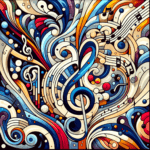When discussing clarinet music, we can't overlook the importance of the E Chromatic Scale. This sequence of twelve pitches, each a half-step apart, has been fundamental to clarinet performance and expression throughout history. It's a staple for clarinetists, offering a foundation for more intricate musical ideas. But what makes the E Chromatic Scale so noteworthy?

Clarinet Fingering Charts are always FREE at MartinFreres.net!
The Basics of the E Chromatic Scale
Let's start with the fundamentals. The E Chromatic Scale includes these notes: E, F, F#, G, G#, A, A#, B, C, C#, D, and D#. This scale isn't just a collection of sounds; it conveys various emotions and hues, making it essential in the artistic expression of clarinet music. Picture it as an artist's palette—the foundation for creating masterpieces!
Historical Significance
Looking back to the classical period, composers like Mozart and Beethoven used scales creatively to convey their ideas and emotions. The E Chromatic Scale in their works allows clarinetists to explore a range of feelings, from joy to sorrow. Mozart's Clarinet Concerto in A major, for example, incorporates chromatic passages that enhance its lyrical and expressive qualities, highlighting the scale's importance.
Innovation in the Romantic Era
Moving to the Romantic era, we see even more inventive use of the E Chromatic Scale. Composers like Brahms and Debussy embraced chromaticism, pushing beyond traditional scale use. They incorporated the E scale into their complex works, creating richer textures and harmonies. This opened up new possibilities for clarinetists to explore longer melodic lines and intricate rhythmic patterns.
| Era | Composers | Use of E Chromatic Scale |
|---|---|---|
| Classical | Mozart, Beethoven | Expressive tool for conveying emotions |
| Romantic | Brahms, Debussy | Expanded use for richer textures and harmonies |
Mastering the E Chromatic Scale
So, how can we learn to use this scale effectively? Practicing the E Chromatic Scale goes beyond just playing the right notes; it's about understanding its real-world applications. Start with long tones to get a good feel for each pitch. A consistent sound can really improve your connection with the notes. Once you've got that down, try playing the scale legato, then switch to staccato to build finger dexterity.
Making Practice Enjoyable
Practice doesn't have to be boring! Try incorporating the E Chromatic Scale into pieces you enjoy. Whether it's jazz, classical, or even pop, exploring how the scale works in different styles will deepen your appreciation as a musician. It's also a great way to impress your friends when you play a cool tune mixing high and low E Chromatic notes!
Exercises and Etudes
There are many etudes and exercises designed specifically for clarinetists to improve their chromatic scale skills. The works of Klosé or Rose can be particularly helpful. These exercises develop not only technical skills but also the understanding needed to smoothly incorporate the E Chromatic scale into performances. Regular practice with these exercises can greatly improve your playing, enhancing both your technical ability and musical interpretation.
Influential Clarinetists and the E Chromatic Scale
We can't forget the influential clarinetists who have showcased stunning applications of this scale. Legends like Benny Goodman and Sabine Meyer didn't just master the E Chromatic Scale; they made it an integral part of their musical storytelling. By studying their recordings, students can see real-life examples of how to dynamically embellish and interpret scales, moving beyond mechanical playing.
Conclusion
The historical significance of the E Chromatic Scale extends beyond just the notes. It's about the journey, the expression, and the evolution of clarinet music itself. Whether you're new to the clarinet or an experienced player looking to deepen your understanding, embracing this scale can transform not just your playing but your entire musical experience.
So pick up your clarinet and let the E Chromatic Scale inspire new musical ideas. Don't be afraid to express yourself. Happy playing!
Table of Contents
- The Basics of the E Chromatic Scale
- Historical Significance
- Mastering the E Chromatic Scale
- Influential Clarinetists and the E Chromatic Scale
- Conclusion








